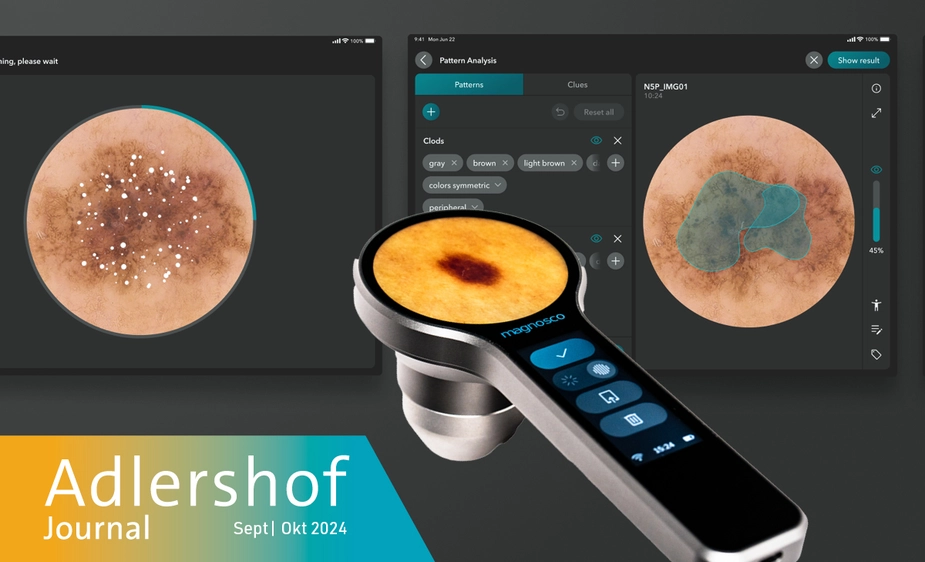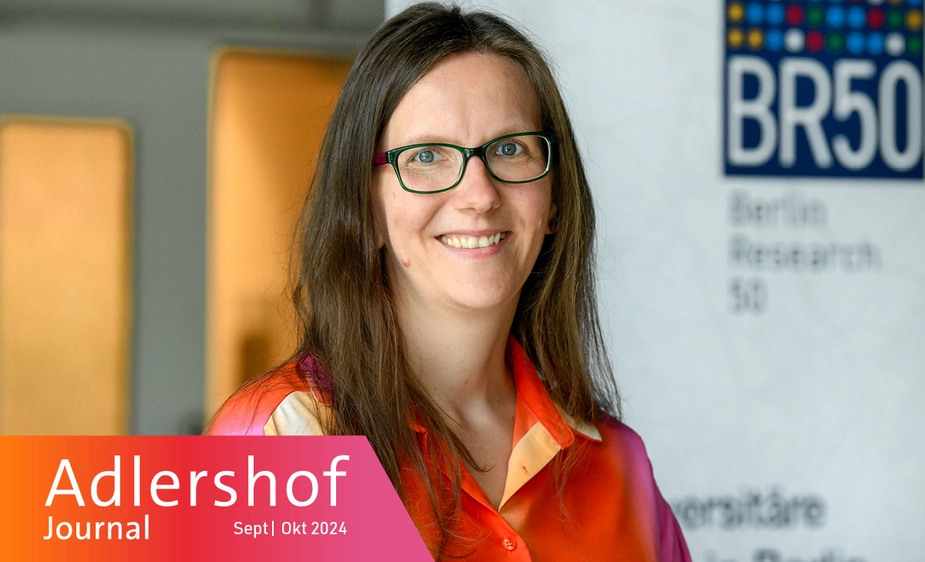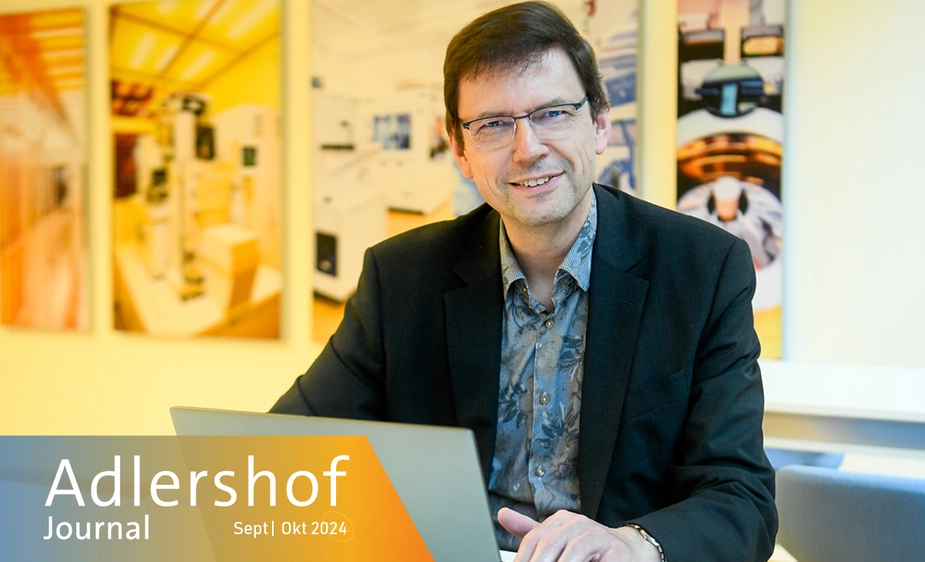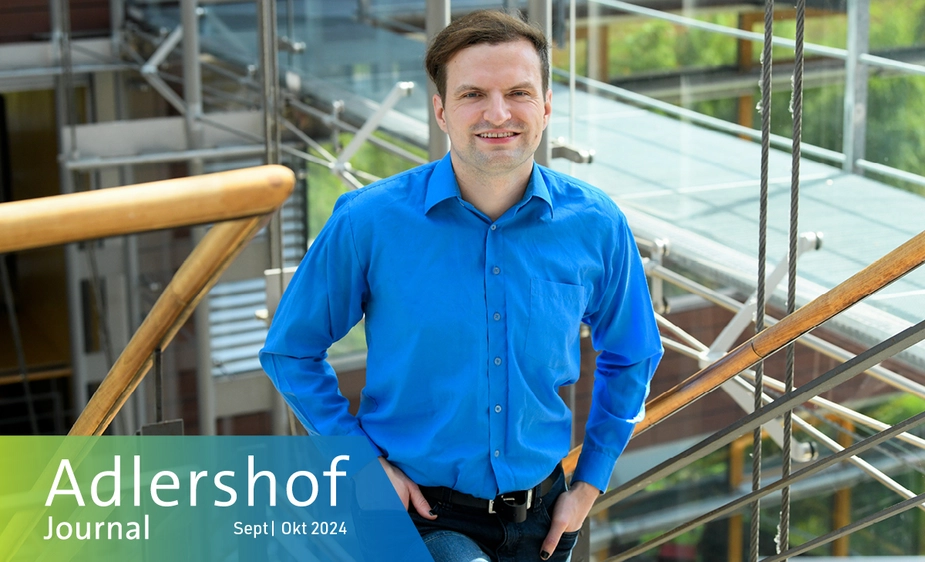Science und Society
How research and innovation secure our future
Without research and innovation, our society would stagnate. The institutes and companies in Adlershof show how it can be done differently every day anew. We will take an in-depth look at how they secure our future and why there is no way around more networking and communication.
“There are alarming increases in skin cancer occurrences, while the number of medical practitioners and the quality of care is decreasing,” says Thomas Diepold, managing director at Magnosco GmbH. The Adlershof-based company is working on putting a halt on this calamitous trend. Their key to to doing so: Digitalisation. “Thanks to the support of smart software we can help optimise diagnostics and disseminate knowledge across the board—think of rural-to-urban migration and demographic changes,” Diepold explains what he calls a “groundbreaking solution”.
He is referring to a system that includes a smart dermatoscope, designed to make high-precision images of tissue damage. Its handling is similar to the analogue magnifying lamp commonly utilised by professionals. The unique and effective design of the instrument recently won the Red Dot “Best of the Best” Award. Moreover, Magnosco is working on an AI-based analysis software aimed at the non-invasive detection of skin tumours and inflammatory skin diseases.
This is one of many examples of how the researchers and entrepreneurs working on the campus serve the common good, benefit society, and drive progress. “Skin cancer is one of the most common cancers in Germany and the consequences for the people and the healthcare system are not to be underestimated,” says Diepold with emphasis. Early detection—especially of melanoma—is a crucial function. “That’s why we are driven to help as many people as possible and develop products that create an added value,” says Diepold. Creating very good care, not just in the metropolitan regions, plays a major role in this. This way, medical practitioners in rural areas can also make early and reliable diagnoses.
“Ethical values and principles should serve as the guardrails for all actions and activities in society, including development,” is Diepold's credo. “At the same time, researchers must be able to work as independently as possible.” Creativity and agility, he says, are important drivers of successful innovation. “We at Magnosco define our goals as a team as well as from an entrepreneurial perspective, but we give us leeway to reach these goals,” says Diepold. “The dynamic and creativity that come from this often make the difference between failing and finding unique and innovative solutions.”
This and collaborative out-of-the-box thinking are the drivers of developments relevant to society. “The greatest challenges of the future are not manageable without interdisciplinary network building among researchers and without the inclusion of policymakers, civil society, and businesses,” says Anja Sommerfeld.
She is the manager of the business office of Berlin Research 50 (BR50) and is responsible for defining the goals of this association, which consists of almost all non-university institutes and facilities in the Berlin area. “We want to facilitate coordination between non-university research institutions and act as a one-stop shop for cooperation with Berlin universities and the exchange with civil society and policymakers,” Sommerfeld explains. Moreover, BR50 wants to offer a platform for dialogue among the participating institutions as well as between science and society.
A key issues paper on the Berlin Research Area, currently in development and set to be published at the end of the year, will demonstrate how networking can be enhanced. “This will also be about how research results can be more effectively brought into society,” says Sommerfeld. As far as communication goes, she says, there’s room for improvement. Too often, outreach is focused solely on one’s own community, those already interested in science and technology, while failing to engage broader segments of society. Sommerfeld believes this must change. One way forward could be more citizen science formats that involve citizens in research directly. Sommerfeld feels that projects from mobility and urbanity are particularly suitable for this purpose because they are close to people’s everyday lives.
“This, too, will create more acceptance for science and research,” says Sommerfeld. Acceptance is low at times. Research results are being doubted and unwanted results lead to threats or other attempts at intimidation. “Freedom of research guaranteed by the constitution is a precious good,” underscores Sommerfeld. It needs to be protected, she says.
Eleven institutes of the Fraunhofer Group for Microelectronics have joined forces with Ferdinand-Braun-Institut (FBH) and the Leibniz Institute for High Performance Microelectronics (IHP) to strengthen the position of the European semiconductor and electronics industry on the global market. They are now pooling their resources and skills in this area in the Research Fab Microelectronics Germany (FMD), which works across locations. “By doing so, we are contributing to safeguarding the security of the economic region,” says Wolfang Heinrich, department head at FBH and professor at Technische Universität Berlin (TU), with emphasis. This is mainly because technologies for future ultrafast wireless communication are being developed here. Specifically: energy-efficient high-performance microchips for the radio interface.
“It’s about technological sovereignty and about making our societies more resilient, economically and technologically. Wireless communication is essential for digitalisation, making it a key issue,” says Heinrich. One that has so far been approached in a monopolistic manner. Manufacturing and system integration of the associated components are now firmly in the hands of the United States and the Far East. This is the reason why FBH in cooperation with FMD is working with the European Chips Act (EuCA), aimed at strengthening chips manufacturing in Germany and Europe. Heinrich explains: “The aim is to make the technologies available for development and prototyping.” From a single source, the entire value chain for microelectronics and nanoelectronics is to be made available to customers from large industrial companies, small and medium-sized enterprises and universities. Heinrich: “FBH is contributing its expertise in the development and realisation of semiconductor components for high-frequency and optoelectronics.”
One of the users of such high-performance chips is Thomas Kosch. The professor at Humboldt-Universität zu Berlin (HU) is head of the teaching and research area Human-Computer Interaction. His work is focused on improving the interaction between artificial intelligence and users by designing novel computer interfaces. “What stands out particularly is our interdisciplinary approach. We combine insights from computer science, psychology, and design to create novel interfaces, which are both intuitive and efficient,” explains Kosch. A highlight of the research is the development of AI-based adaptive interfaces that can adapt to the needs and conditions of users in real time, using physiology and user context. “Moreover, our work has allowed us to lay the foundation for new standards in this field,” Kosch adds.
In doing so, Kosch’s working group is playing a central role in pushing society forward through research and development in the field of human-computer interaction. “We are developing technologies and interfaces with a focus in AI that are available to everybody,” says Kosch. “As a result, we are contributing to digital inclusion and are enabling more people to take part in a digital life and benefit from novel technologies.”
Aim of the research is to make the interaction between humans and computers more intuitive and efficient. Kosch: “By analysing physiological data, we develop systems that reduce stress and promote well-being by detecting when users are stressed and making appropriate adjustments.” The scientists also create innovative teaching and learning tools that facilitate understanding and application of modern technologies and prepare the next generation of professionals for the challenges of the digital future.
It is also conceivable that the work of the Adlershof-based researchers results in intelligent assistance systems in healthcare that can propose preventive measures or optimise individual therapy plans, which would significantly increase people’s quality of life and satisfaction. It goes without saying that this research will also benefit human societies.
Chris Löwer for Adlershof Journal




